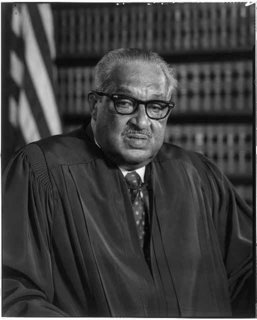

Thurgood Marshall (July 2, 1908- January 24, 1993) was an American
jurist and the first African American to serve on the United States
Supreme Court.
Personal life
Marshall was born in Baltimore, Maryland. His parents, William and
Norma, named him "Thoroughgood" after his great-grandfather,
a former slave who had fought for the Union Army during the Civil War.
However, Marshall found the name cumbersome and was known as Thurgood
from childhood.
During his time in Frederick Douglass High School, he was considered at best a mediocre student if not simply a troublemaker, and was often sent to the principal's office for disciplinary reasons. A frequently used punishment was requiring him to memorize a portion of the constitution, which he would then have to recite before being excused. As a result, by the time he left high school he "knew the whole thing by heart," setting the foundation for his pursuit of a career in law.
Marshall graduated from Lincoln University in 1930. Afterward, Marshall thought of applying to his hometown law school at the University of Maryland School of Law. He did not, however, because he knew the school's formal segregation policy would have denied him admission.
Instead, Marshall sought admission and was accepted at Howard University. He was influenced by its dynamic new dean, Charles Hamilton Houston, who instilled in his students the desire to apply the tenets of the Constitution to all Americans.
Marshall was married twice; to Vivien "Buster" Burey from 1929 until her death in February 1955 and to Cecilia "Cissy" Suyat from December 1955 until his death in 1993. Marshall had two sons from his second marriage; Thurgood Marshall Jr., a former top aide to President Bill Clinton, and John W. Marshall, who is currently Secretary of Public Safety in the Cabinet of Virginia Governor Mark Warner and a former United States Marshals Service Director.
Marshall was a prominent member of Alpha Phi Alpha Fraternity Inc.,
the first intercollegiate Greek-letter fraternity established for African
Americans.
Law career
Murray v. Maryland
Marshall received his law degree from Howard in 1933, and
set up a private practice in Baltimore. The following year, he began
working
with the Baltimore NAACP. He won his first major civil rights case,
Murray v. Maryland, 169 Md. 478 (1936). This involved the first attempt
to chip away at Plessy, a plan created by his co-counsel on the case
Charles Hamilton Houston. Marshall represented Donald Gaines Murray,
a black Amherst College graduate with excellent creditials who had
been denied admission to the University of Maryland Law School because
of its separate but equal policies. this policy required black students
to accept one of three options: attend Morgan College, the Princess
Anne Academy, or out-of-state black institutions. In 1935, Thurgood
Marshall argued the case for Murray, showing that neither of the in-state
institutions offered a law school and that such schools were entirely
unequal to the University of Maryland. Marshall and Houston expected
to lose and intended to appeal to the federal courts. The Maryland
Court of Appeals ruled against the state of Maryland and its Attorney
General, who represented the University of Maryland, stating “Compliance
with the Constitution cannot be deferred at the will of the state.
Whatever system is adopted for legal education now must furnish equality
of treatment now”. Because the state did not appeal the ruling
in the federal courts, this state ruling under the U.S. Constitution
was the first to overturn Plessy. While it was a moral precedent, it
was not a legal one, and had no authority outside the state of Maryland.
Marshall won his first Supreme Court case, Chambers v. Florida, 309 U.S. 227 (1940). That same year, at the age of 32, he was appointed Chief counsel for the NAACP. He argued many other cases before the Supreme Court, most of them successfully, including Smith v. Allwright, 321 U.S. 649 (1944); Shelley v. Kraemer, 334 U.S. 1 (1948); Sweatt v. Painter, 339 U.S. 629 (1950); and McLaurin v. Oklahoma State Regents, 339 U.S. 637 (1950). His most famous case as a lawyer was Brown v. Board of Education of Topeka, 347 U.S. 483 (1954), the case in which the Supreme Court ruled that "separate but equal" public education was unconstitutional because it could never be truly equal. In total, Marshall won twenty-nine out of the thirty-two cases he argued before the Supreme Court.
President Kennedy appointed Marshall to the United States Court of
Appeals for the Second Circuit in 1961. A group of Democratic Party
Senators led by Mississippi's James Eastland and West Virginia's Robert
Byrd held up his confirmation, so he served for the first several months
under a "recess appointment." Marshall remained on that court
until 1965, when President Lyndon Johnson appointed him Solicitor General.
U.S. Supreme Court
On June 13, 1967, President Johnson appointed Marshall to
the Supreme Court following the retirement of justice Tom C. Clark,
saying that
this was "the right thing to do, the right time to do it, the
right man and the right place." He was the 96th person to hold
the position, and the first African-American. President Johnson confidently
predicted to one biographer, Doris Kearns, that a lot of black baby
boys would be named "Thurgood" in honor of this choice.
Marshall served on the Court for the next twenty-four years, compiling a liberal record that included strong support for Constitutional protection of individual rights, especially the rights of criminal suspects against the government. His most frequent ally on the Court was Justice William Brennan, who consistently joined him in opposing the death penalty. Marshall announced his retirement at the end of his term on June 28, 1991, citing his age and declining health as reasons.
Among his many law clerks were Chief Judge Douglas Ginsburg of the D.C. Circuit Court of Appeals and well-known law professor Cass Sunstein.
There is a memorial to Justice Marshall near the Maryland State House.
This biography is courtesy of Wikipedia, the free encyclopedia